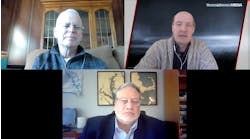From mid-September through October1997, the project team constructed12 test sections on a six-mile stretch of the K-96 Highway in Reno County. "Because this special project demonstrated such a great number of techniques, it very well may be the broadest in scope of all the research going on over the past few years," said John Wojakowski, KDOT concrete research engineer.
Alan Farrington, vice president and project engineer for Wittwer Paving, commented that the uniqueness of the project is due in part to the extraordinary length of each test section. "Normally, sections are relatively short–500 to 600 ft," he explained. "Most of the sections in this project were 3,000 ft long."
Innovation showcased
The test sections varied greatly, ranging from the typical construction of the control section to two-lift construction using reclaimed asphalt pavement (RAP) as the base. An overview of the12 sections is as follows:
Typical construction included:
- Single saw cut, no joint sealant;
- FiberCon dowels;
- Five X-Flex joints;
- Initial control cuts utilizing Soft-Cut, Magnum, and Target Early-cut saws;
- 3M polyolefin fibers;
- Longitudinal tining;
- Special high-solids curing compound;
- Two-lift using15% RAP in the bottom 7-in. layer and typical concrete mix in the top 3 in.;
- High-range water reducer;
- Two-lift with high-absorption limestone in the bottom and rhyolite aggregate and Dura-Poz pozzolan in the top; and
- Two-lift with high-absorption limestone in the bottom and high-range water reducer in the top.
Two-lift construction challenges
Three of the test sections called for two-lift construction, with one section using RAP as part of the bottom layer. "To my knowledge, using a15% asphalt mix for the bottom has never been done before," Farrington said. Another unique feature of the two-lift construction was Wittwer's use of only one paving machine with two belt placer/spreaders. "The budget was limited," explained Farrington. "This technique allowed us to squeeze more out of it. Wojakowski agreed the method produced a substantial cost saving without compromising quality. "The distinction between the two layers isn't as well defined as with the standard two-pass method, but, all in all, it seemed to work just fine," he commented. Another challenge arose with the mixing and placing of the section featuring 3M Polyolefin Fibers. The addition of the fibers to the mix doubled mixing and placing time and decreased rideability. Farrington is interested in future performance of the section using FiberCon 2 in.-diam fiberglass tubing filled with hydraulic cement and put in a basket assembly. "I'm curious to see if the testing shows it holds up better than standard steel dowels," he said.
A critical look
Now that the project is complete, the waiting starts, with observation and testing to occur over the next five years. In addition to annual visual inspections, KDOT will evaluate the sections' performance by measuring deflections and roughness, testing surface friction, and mapping distress. "We'll write our final report in five years," said Wojakowski. "But we hope to monitor the sections for an even longer time."
Early findings point to success
Although the majority of the evaluation will not be done for several years, Farrington commented on some preliminary results. He reported the early soft cut worked quite well. "They varied the depths, and we're finding certain depths worked better than others," he said. Other findings include: longitudinal tining proved quieter for heavy vehicles, the section with low water/cement ratio with the high-range water reducer paved very nicely, and the better curing compound worked well. "Further testing will reveal if the expensive curing compound was worth the cost," Wojakowski said.
Open house spreads the word
On Sept. 23,1997,128 people from all over the nation gathered in Wichita to learn about the K-96 research project. Contractors and material suppliers, as well as representatives from FHWA,14 state DOT's and several cities attended the open house. Wojakowski and Farrington both gave informative presentations on their involvement in the test project. Steve Tritsch, chapter executive with the MO/KS Chapter of the ACPA also spoke, recognizing all the participants in the project. The success of the K-96 research project resulted from the teamwork and cooperation between KDOT, Wittwer Paving, and the MO/KS Chapter of the ACPA. Tritsch drafted the problem statement and encouraged KDOT to submit the request to the FHWA, working closely with Wojakowski and Farrington. Wojakowski was impressed with the contractor's performance on such a challenging job. "Wittwer was very cooperative and efficient," he said, adding, "Alan did a fine job of coordinating and placing the test sections when materials were unavailable at the originally scheduled times."
Future looks bright for HPRP
Will the innovative concepts demonstrated by the K-96 research project become common practice in the industry? Farrington thinks so. "Successfully completing new processes and procedures that we've never tried before will definitely give us an edge," says Farrington. Wojakowski, also, sees good things coming out of the project. "These new technologies make concrete pavement an even better value, and result in more advantageous use of public funds." "The Kansas HPCP is probably the most significant research project in the last five years," states Tritsch. "I'm especially excited about the use of RAP in the two-lift construction. This innovation could be extremely important in future years when we have to recycle more and more. KDOT had a lot of foresight in following through with this research. I'm confident many long-term benefits will come from it."


